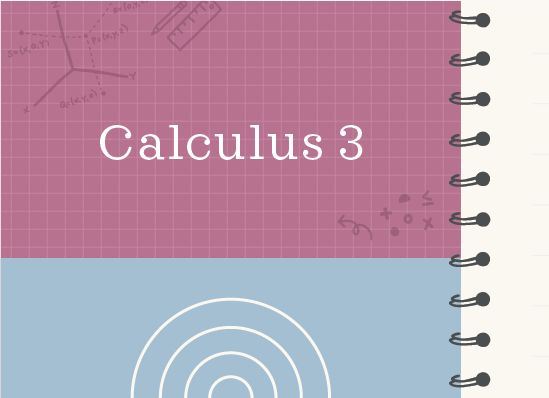Finding the vector orthogonal to the plane
Formulas we’ll use to find the vector that’s orthogonal to the plane equation
To find the vector orthogonal to a plane, we need to start with two vectors that lie in the plane.
Sometimes our problem will give us these vectors, in which case we can use them to find the orthogonal vector.
Hi! I'm krista.
I create online courses to help you rock your math class. Read more.
Other times, we’ll only be given three points in the plane. If we only have the three points, then we need to use them to find the two vectors that lie in the plane, which we’ll do using these formulas:
Given points ???A(a_1,a_2,a_3)???, ???B(b_1,b_2,b_3)???, and ???C(c_1,c_2,c_3)???
???\vec{AB}=(b_1-a_1)\bold i+(b_2-a_2)\bold j+(b_3-a_3)\bold k???
???\vec{AB}=(AB_1)\bold i+(AB_2)\bold j+(AB_3)\bold k???
???\vec{AB}=AB\langle{AB_1},AB_2,AB_3\rangle???
and
???\vec{AC}=(c_1-a_1)\bold i+(c_2-a_2)\bold j+(c_3-a_3)\bold k???
???\vec{AC}=(AC_1)\bold i+(AC_2)\bold j+(AC_3)\bold k???
???\vec{AC}=AC\langle{AC_1},AC_2,AC_3\rangle???
Once we have our vectors, whether they were given or whether we calculated them using three points in the plane, we’ll take their cross product.
???\begin{vmatrix}\bold i&\bold j&\bold k\\AB_1&AB_2&AB_3\\AC_1&AC_2&AC_3\end{vmatrix}=\bold i\begin{vmatrix}AB_2&AB_3\\AC_2&AC_3\end{vmatrix}-\bold j\begin{vmatrix}AB_1&AB_3\\AC_1&AC_3\end{vmatrix}+\bold k\begin{vmatrix}AB_1&AB_2\\AC_1&AC_2\end{vmatrix}???
???=\bold i(AB_2AC_3-AB_3AC_2)-\bold j(AB_1AC_3-AB_3AC_1)+\bold k(AB_1AC_2-AB_2AC_1)???
The result is the vector orthogonal to the plane.
Finding the vector orthogonal to the plane
Take the course
Want to learn more about Calculus 3? I have a step-by-step course for that. :)
Given three points in the plane, find the vector that’s orthogonal to the plane
Example
Find the vector orthogonal to the plane that includes the given points.
???A(1,3,2)???
???B(-2,4,1)???
???C(3,0,-2)???
We need to use these three points to find two vectors that lie in the plane, so that we can then find the cross product of those vectors.
???\vec{AB}=(b_1-a_1)\bold i+(b_2-a_2)\bold j+(b_3-a_3)\bold k???
???\vec{AB}=(-2-1)\bold i+(4-3)\bold j+(1-2)\bold k???
???\vec{AB}=-3\bold i+\bold j-\bold k???
???\vec{AB}=AB\langle-3,1,-1\rangle???
and
???\vec{AC}=(c_1-a_1)\bold i+(c_2-a_2)\bold j+(c_3-a_3)\bold k???
???\vec{AC}=(3-1)\bold i+(0-3)\bold j+(-2-2)\bold k???
???\vec{AC}=2\bold i-3\bold j-4\bold k???
???\vec{AC}=AC\langle2,-3,-4\rangle???
Once we have our vectors, whether they were given or whether we calculated them using three points in the plane, we’ll take their cross product.
Now we’ll take the cross product of ???\vec{AB}??? and ???\vec{AC}???.
???\vec{AB}\times\vec{AC}=\begin{vmatrix}\bold i & \bold j & \bold k \\ -3 & 1 & -1 \\ 2 & -3 & -4\end{vmatrix}???
???\vec{AB}\times\vec{AC}=\bold i\begin{vmatrix}1 & -1 \\ -3 & -4\end{vmatrix}-\bold j\begin{vmatrix}-3 & -1 \\ 2 & -4\end{vmatrix}+\bold k\begin{vmatrix}-3 & 1 \\ 2 & -3\end{vmatrix}???
???\vec{AB}\times\vec{AC}=\left[(1)(-4)-(-1)(-3)\right]\bold i-\left[(-3)(-4)-(-1)(2)\right]\bold j+\left[(-3)(-3)-(1)(2)\right]\bold k???
???\vec{AB}\times\vec{AC}=(-4-3)\bold i-(12+2)\bold j+(9-2)\bold k???
???\vec{AB}\times\vec{AC}=-7\bold i-14\bold j+7\bold k???
???\vec{AB}\times\vec{AC}=\langle-7,-14,7\rangle???
This is the vector which is orthogonal to the plane that includes the given points.






